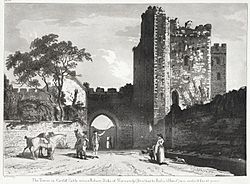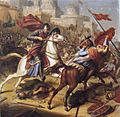Robert Curthose facts for kids
Quick facts for kids Robert Curthose |
|
|---|---|

Robert in a 19th-century painting by Henri Decaisne
|
|
| Duke of Normandy | |
| Tenure | 9 September 1087 – 1106 |
| Predecessor | William the Conqueror |
| Successor | Henry Beauclerc |
| Born | c. 1051 Normandy, France |
| Died | 3 February 1134 (aged c. 83) Cardiff Castle, Glamorgan |
| Burial | Gloucester Cathedral, Gloucestershire |
| Spouse | Sybilla of Conversano |
| Issue | William Clito |
| House | Norman dynasty |
| Father | William the Conqueror |
| Mother | Matilda of Flanders |
Robert Curthose (around 1054–1134) was the Duke of Normandy from 1087 to 1106. He was also the Count of Maine for a time. Robert is known for his disagreements with his brothers, especially over who would rule England. These conflicts eventually led to the region of Normandy being controlled by the King of England.
Contents
Robert's Early Life and Family
Robert Curthose was the oldest son of William the Conqueror. William was the first Norman king of England. Robert's mother was Matilda of Flanders. He was born around 1054. When he was a child, he was supposed to marry Margaret, who was the future ruler of Maine. But she died before they could get married. Robert did not marry until he was in his late forties.
Robert grew up around his father's soldiers and leaders. This helped him become a very skilled fighter. However, unlike his father, Robert enjoyed a life of fun and luxury. In 1063, his father made him the Count of Maine. But Robert did not have real power there. His father actually controlled Maine until 1069. At that time, the people of Maine rebelled, and the county went back to Hugh V of Maine. Even so, Robert was still seen as his father's heir. The important leaders had sworn loyalty to him twice, promising to follow him in the future.
Disagreements with His Father
In 1077, Robert had a big argument with his father, William the Conqueror. Robert demanded to rule Normandy, a job he had done sometimes when William was in England. William could not make his son see reason, and Robert left very angry. The next day, Robert and his supporters tried to take over the city of Rouen. But their attempt failed. After rebelling against his father, Robert had to leave the country.
Robert first went to Chateauneuf-en-Thymerais. Then he fled to Flanders, where his uncle Robert I, Count of Flanders lived. By the spring of 1080, Robert was back on good terms with his father. William again named Robert as his heir for Normandy, with his leaders present. Later that year, Robert went with his father to England. William put Robert in charge of a large army. Their mission was to go north and deal with King Malcolm III of Scotland. Malcolm had been attacking northern England while William was busy in Normandy. When the two armies got close, Malcolm did not want to fight. He again promised loyalty to King William and gave him important people as a guarantee.
Robert stayed in England with his father until the end of 1081. Events in Maine then made William and Robert return to Normandy. Fulk IV, Count of Anjou had been attacking Maine again, trying to take control from Normandy. William and Robert led a large army into Maine to face the Count of Anjou. Before any fighting could start, a religious leader and some monks stopped the battle. They asked for a break in the fighting, and after many talks, an agreement was reached. The Count of Anjou would let Normandy keep Maine. But Robert, as Count of Maine, had to recognize Fulk IV as his higher lord for Maine. When Queen Matilda, Robert's mother, died in 1083, Robert seemed to leave his father's side. He and his mother had been very close.
Becoming Duke of Normandy
In 1087, William the Conqueror died. He had been hurt in a riding accident during a fight in Mantes. It is said that before he died, William wanted to prevent his oldest son from inheriting. But he was convinced to divide his lands between his two oldest sons. Robert received the Duchy of Normandy. His brother, William Rufus, received the Kingdom of England. The youngest son, Henry, was given money to buy land.
Of the two older sons, Robert was seen as the weaker leader. Important nobles who owned land in both England and Normandy often preferred him. This was because they could more easily ignore his authority. When their father died, Robert and William Rufus agreed to be each other's heir. However, this peace lasted less than a year. Some nobles joined Robert to try and remove William Rufus from power in the Rebellion of 1088. This attempt failed, partly because Robert never arrived to help the English rebels.
Robert chose Ranulf Flambard as his main advisor. Flambard had also been a close advisor to Robert's father. Later, Flambard became a clever but disliked financial advisor to William Rufus until William's death in 1100.
The First Crusade and Losing Normandy
In 1096, Robert left for the Holy Land to join the First Crusade. At the time he left, he was reportedly so poor that he often had to stay in bed because he had no clothes. To get money for the crusade, he borrowed money from his brother William. He used his duchy of Normandy as a guarantee, for a large sum of 10,000 marks.
When William II died on August 2, 1100, Robert was on his way back from the Crusade. He was about to marry a rich young woman to get money to buy back his duchy. Because of this, his brother Henry was able to quickly take the crown of England for himself. When Robert returned, he was urged by Flambard and other Norman nobles to claim the English crown. He based his claim on the short agreement he had made with William Rufus in 1087.
In 1101, Robert led an invasion to remove his brother Henry from power. He landed at Portsmouth with his army. But he did not have much support among the English people. Also, Robert did not manage the invasion well. This allowed Henry to stop the invasion. Robert was forced to give up his claim to the English throne in the Treaty of Alton. It is said that Robert was a brilliant fighter on the battlefield but not a good overall leader during the First Crusade. His poor rule of Normandy and his failed invasion of England suggest that his military skills were not much better than his political skills.
In 1105, Robert kept causing trouble with his brother in England. There was also disorder in Normandy itself. This made Henry decide to invade Normandy. In 1106, Henry completely defeated Robert's army at the Battle of Tinchebray. Henry then claimed Normandy as part of the English crown. This situation lasted for almost a century. After the battle, Robert was captured. He was held in Devizes Castle for twenty years. Later, he was moved to Cardiff.
Robert's Death and Burial
In 1134, Robert died in Cardiff Castle. He was in his early eighties. Robert Curthose, who was once the Duke of Normandy and the oldest son of William the Conqueror, was buried in the church of St. Peter in Gloucester. The exact spot where he was buried is not clear. Some stories say he asked to be buried in front of the main altar. His statue, carved from bog oak, lies on a decorated chest. The statue was made about 100 years after he died, and the chest was made much later. The church later became Gloucester Cathedral.
Robert's Family

Robert married Sybilla of Conversano on his way back from the Crusade. She was the daughter of Geoffrey of Brindisi, Count of Conversano. She was also a grandniece of Robert Guiscard, another Norman duke. They had one child:
- William Clito (1102—1128); he did not have any children.
Robert also had at least three children outside of marriage:
- Richard, who died while hunting in the New Forest in May 1100.
- William.
- An unnamed daughter who married Helias of Saint-Saens.
Images for kids
-
Robert Curthose during the Siege of Antioch, as imagined by Jean-Joseph Dassy
-
Robert's tomb in Gloucester Cathedral
See also
 In Spanish: Roberto II de Normandía para niños
In Spanish: Roberto II de Normandía para niños



